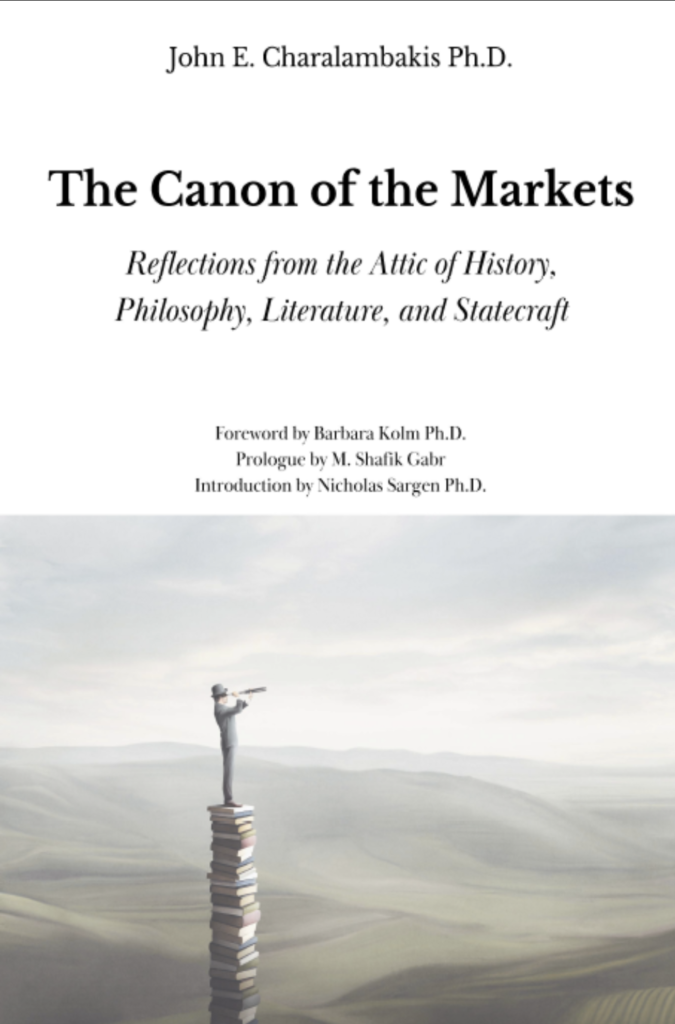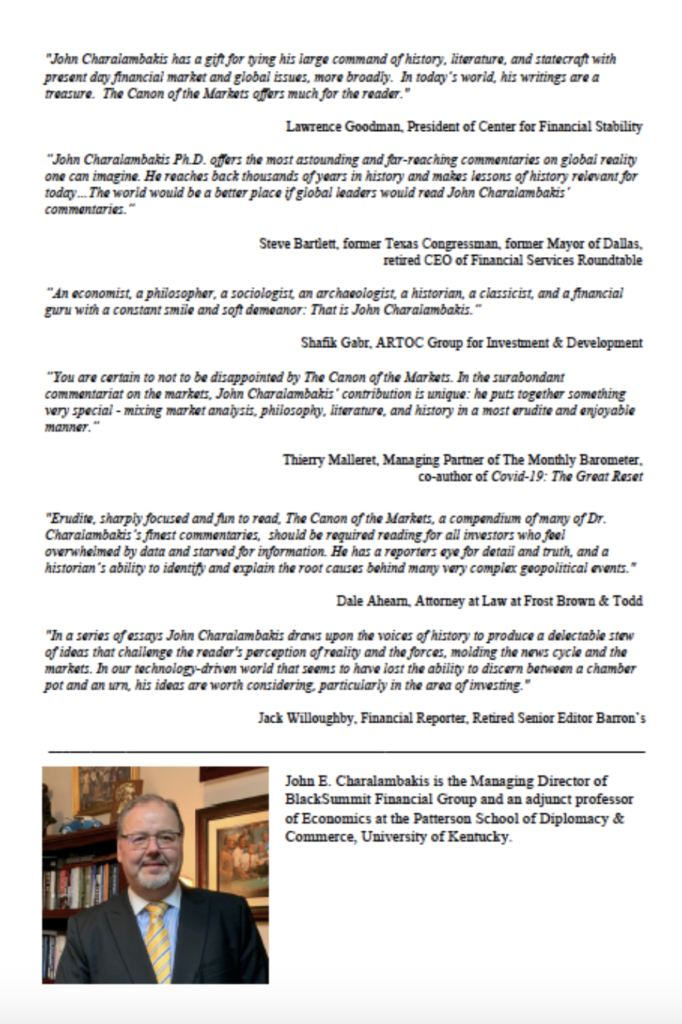“Erudite, sharply focused and fun to read, The Canon of the Markets, a compendium of many of Dr. Charalambakis’ finest commentaries, should be required reading for all investors who feel overwhelmed by data and starved for information. He has a reporter’s eye for detail and truth, and a historian’s ability to identify and explain the root causes behind many very complex geopolitical events.”
Dale Ahearn, Attorney at Law at Frost Brown & Todd
We invite you to check out John’s new book, The Canon of the Markets: Reflections from the Attic of History, Philosophy, Literature, and Statecraft. This collection of John’s commentaries on financial markets and statecraft is now available for purchase on Amazon.com (see bottom of this message).
Introduction: As the crisis in Ukraine continues to unfold, it is important to maintain a holistic view of global developments, contextualizing the present through the lens of the past. To begin our look at the Day After this week, we examine two key components of the crisis: Putin’s subversive rhetoric around Russia’s position, and Ukraine’s economic centrality in the Eurasian continent. From there, we look at how a recent uptick in global growth is likely to face headwinds from long-term trends in depopulation, declining productivity, deglobalization and debt. At the same time, while the coronavirus is waning in some areas of the world, the recovery for most of the globe will be a slow and difficult process. Finally, we conclude with a look at how the emerging technology of the metaverse is influencing education.
Piece by Piece, Russia’s Rationale for a Ukraine Invasion Is Put in Place
Anton Troianovski, The New York Times
Russia is waging a war of disinformation. The narrative being told by pro-Russia propaganda is far from reality. Across Russia’s television screens, state-run media outlets have been flashing scenes of war, “genocide,” pleas from separatists to evacuate women and children from eastern Ukraine, a televised Security Council meeting, and President Vladimir Putin’s dramatic addresses to the nation. The reality is Ukraine is not the aggressor and Putin has been carefully crafting his rationale for an invasion of Ukraine for the last several weeks. While Kyiv insists it has no plans to launch an offensive on separatist-held territories of Ukraine, Putin continues to paint Ukraine and its American and European allies as warmongers. With his propaganda, Putin seeks to justify a war with Ukraine and gain public support, but until recently, most Russians seem to have tuned out the possibility of war. No antiwar movements have emerged over the last few weeks and there was relatively little chatter of possible war with Ukraine online before the barrage of propaganda over the last few days. According to Moscow social anthropologist, Aleksandra Arkhipova, Russians “feel like they can’t influence the process at all…so they try to avoid it.” With crippling Western economic sanctions coming Russia’s way, Putin will have to step up his game if he hopes to win the nation’s support for a war with Ukraine.
How a Russian Invasion of Ukraine, the ‘Breadbasket of Europe,’ Could Hit Supply Chains
Weizhen Tan, CNBC
Oil prices closed just over $92 on Wednesday as the world waited and watched the unfolding crisis in Ukraine. As one of Europe’s foremost suppliers of natural resources, Ukraine holds a key strategic position in the European economic system, providing food, energy, and raw materials. The country is a natural food valley, exporting corn, wheat, rye, and barley to neighbors east and west; should the situation escalate, food security across Europe, the Middle East, and even China could be threatened. Food prices have already been rising as a result of the tensions. Should Putin succeed in annexing the country, Russia would be responsible for about 29% of global wheat production. Ukraine is also rich in natural resources such as copper, nickel, and platinum; much of the US semiconductor market depends on Ukrainian neon. Even as supply chains continue to recover from the seismic impacts of the coronavirus pandemic, a further disruption due to the Russian incursion into Ukraine could be catastrophic.
Slower Growth and Higher Inflation are the Hallmarks of a Post-Covid World
Ruchir Sharma, Financial Times
A hot uptick in global growth is generating breathless headlines. In fact, India is on pace to be “the world’s fastest growing large economy” and France is posting its “strongest growth in 52 years”. President Joe Biden cites the latest quarterly growth data as evidence that the US economy is growing “faster than China’s” for the first time in two decades and is “finally building an American economy for the 21st century”. Consider this comparison – The financial crisis of 2008 marked a major turn in the world economy as flows of trade and people slowed. Further, the flows of money collapsed. Burnt by the crisis, many households in the developed world cut back debt. Global productivity growth fell back towards 1 per cent, even as labor-saving digital technology continued to spread. Overall, the global economy grew at barely more than 2.5 per cent a year in the 2010s — the slowest decadal pace in postwar history. The four “Ds” – depopulation, declining productivity, deglobalization and debt — allweighed on growth. The pandemic has only magnified those factors. Countries need to reconsider how fast they can grow in the new era. High-income countries such as the US that still aim for 3 per cent annual growth will be lucky to top 2 per cent in this decade. Lower-income nations such as India need to lower their benchmark for success from 7 per cent to 5 per cent or better. Therefore, rather than hyping a temporary spike in growth data, it is time to recognize that a post-pandemic world shaped by the four Ds is likely to result in even slower growth and higher inflation.
The Looming Threat of Long Financial Covid
Martin Wolf, Financial Times
Economic activity contracted in 90 per cent of the world’s countries in 2020. This exceeded the proportion hit by the two world wars, the Great Depression, and the global financial crisis. A pandemic, we now know, is a comprehensive disaster. “In 2020, the average total debt burden of low- and middle-income countries increased by roughly nine percentage points of the gross domestic product, compared with an average annual increase of 1.9 percentage points over the previous decades. Fifty-one countries (including forty-four emerging economies) experienced a downgrade in their sovereign debt credit rating.” Fifty-three per cent of low-income nations are now seen to be at high risk of debt distress. The most important source of “economic long Covid” is likely to be financial distress. Emerging and developing countries do not only have historically high ratios of public debt to GDP. They also have other symptoms. Among other things, notes the WDR, there have been jumps in arrears of governments in sub-Saharan Africa as well as clear signs of corporate distress. The balance sheets of households, non-financial businesses, financial businesses, government and foreign creditors are interlinked. As the WDR notes, “In many countries, the crisis response has included large-scale debt relief measures, such as debt moratoria and freezes on credit reporting.” Recovery from the pandemic will be slow in many emerging and developing countries, which lack medical and financial means to deal with it properly. In addition, we must now expect higher interest rates in the US and elsewhere. Leading policymakers need to recognize the risks, especially the financial risks to a truly global recovery.
A Whole New World: Education Meets the Metaverse
Kathy Hirsh-Pasek, et. al., Brookings
The metaverse is upon us. As technology advances to bring us new immersive and imaginary worlds, how we educate children and prepare teachers must also advance to meet these new opportunities. When education lags the digital leaps, the technology rather than educators defines what counts as educational opportunity. Forbes Magazine offered varied definitions of the metaverse from tech leaders. Each speaks of a space that is a combination of virtual and live-creating a “third space,” as sociologist Ray Oldenburg noted, that is not home or work. The metaverse of the future is likely to fully support augmented and virtual reality, artificial intelligence, and the connectivity to link all worlds. Indeed, in its most democratic instantiation, anyone will have the opportunity to create a space and be part of a user-generated global community on an interoperable multiplatform where they can share their games or goods with the world. A range of education stakeholders, including learning and development researchers, educators, and employers reached consensus that success in the workplace of tomorrow will require mastery of a suite of skills or what the Brookings Institution has termed, “skills for a changing world.” Such skills, like collaboration, critical thinking, and creative innovation, broaden our view of achievement beyond core academic subjects like reading and math. In this world, children will have first-hand experiences in foreign lands, master a broader suite of skills needed for success, and be better equipped to transfer what they learn into the real world of people and places.


